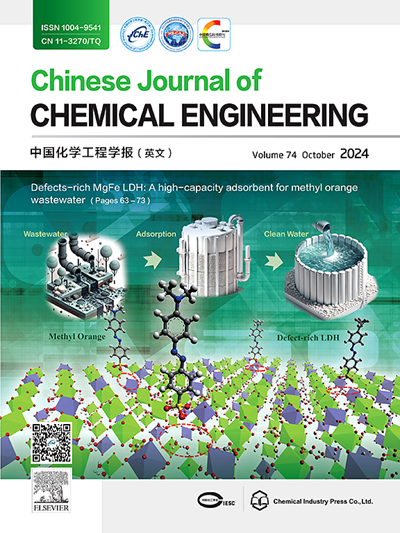Numerical simulation analysis of particle motion behavior and key structures inside a novel cyclone separator
IF 3.7
3区 工程技术
Q2 ENGINEERING, CHEMICAL
引用次数: 0
Abstract
This study proposes a novel cyclone separator with a conical inner core to enhance particle classification efficiency in oil and gas wellhead-recovered liquids. Particle motion and force dynamics are analyzed to optimize key structural parameters, including inlet diameter (Di), overflow pipe diameter (De), insertion depth (Le), and bottom flow pipe diameter (Dz). Numerical simulations employ the Reynolds stress turbulence model, SIMPLEC algorithm, and discrete phase model to evaluate separation performance in a gas–liquid two-phase system. Results indicate that a smaller Di improves fine particle separation but increases turbulence; an optimal range of Di/Dc = 0.35–0.4 is recommended. Larger De enhances the diversion ratio, aiding fine particle discharge (De/Dc = 0.25–0.35). Increased Le facilitates fine particle overflow but induces vortices, whereas a smaller Le stabilizes the bottom flow for larger particle separation (Le/Dc = 0.5–0.75). A reduced Dz enhances centrifugal force and separation efficiency but may cause turbulence; an optimal Dz/Dc of 0.6–0.65 is suggested for stability. These findings provide valuable design guidelines for improving cyclone separator performance in multiphase flow applications.

新型旋风分离器内颗粒运动特性及关键结构的数值模拟分析
为了提高油气井口回收液的颗粒分级效率,提出了一种新型的锥形内芯旋风分离器。对颗粒运动和力动力学进行分析,优化关键结构参数,包括进口直径(Di)、溢流管径(De)、插入深度(Le)和底流管径(Dz)。数值模拟采用雷诺应力湍流模型、SIMPLEC算法和离散相模型对气液两相系统的分离性能进行了评价。结果表明,较小的Di有利于细颗粒的分离,但增加了湍流度;推荐Di/Dc范围为0.35 ~ 0.4。较大的De增大导流比,有利于细颗粒的排出(De/Dc = 0.25 ~ 0.35)。增大的Le有利于细颗粒溢出,但会引起涡旋,而较小的Le则有利于大颗粒分离的底流稳定(Le/Dc = 0.5 ~ 0.75)。减小的Dz增大了离心力和分离效率,但可能引起湍流;最佳Dz/Dc为0.6 ~ 0.65。这些发现为改善多相流应用中旋风分离器的性能提供了有价值的设计指导。
本文章由计算机程序翻译,如有差异,请以英文原文为准。
求助全文
约1分钟内获得全文
求助全文
来源期刊

Chinese Journal of Chemical Engineering
工程技术-工程:化工
CiteScore
6.60
自引率
5.30%
发文量
4309
审稿时长
31 days
期刊介绍:
The Chinese Journal of Chemical Engineering (Monthly, started in 1982) is the official journal of the Chemical Industry and Engineering Society of China and published by the Chemical Industry Press Co. Ltd. The aim of the journal is to develop the international exchange of scientific and technical information in the field of chemical engineering. It publishes original research papers that cover the major advancements and achievements in chemical engineering in China as well as some articles from overseas contributors.
The topics of journal include chemical engineering, chemical technology, biochemical engineering, energy and environmental engineering and other relevant fields. Papers are published on the basis of their relevance to theoretical research, practical application or potential uses in the industry as Research Papers, Communications, Reviews and Perspectives. Prominent domestic and overseas chemical experts and scholars have been invited to form an International Advisory Board and the Editorial Committee. It enjoys recognition among Chinese academia and industry as a reliable source of information of what is going on in chemical engineering research, both domestic and abroad.
 求助内容:
求助内容: 应助结果提醒方式:
应助结果提醒方式:


